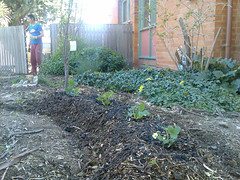As Autumn settles in, we've been doing a bit of clean-up of our vegies and native front garden. In addition, we've been working out preparations for the orchard trees, especially our two Japanese plums, Santa Rosa and Mariposa. I've been sifting through the web and our companion planting book for info on pruning times and procedures and fertilising. There's a mish-mash of info around, so I've attempted to pull some info together as a result. You can also jump into forums like Daly's Fruit Trees for further help from 'experienced others'.
Santa Rosa and Mariposa varieties
These two Japanese varieties are fairly hardy and can grow in most climates, as with the European varieties. They are said to respond well to 'low chill', which makes them ideal for more milder Winters. 'Low chill' means that they can set buds without requiring a long winter chill (European varieties on the other hand need a long chill time to set their buds). In Canberra the frosts provide the chill, but sometimes the winter itself may not be a long one, so we're confident the plums will do well here.
We planted the two plums in June of last year and they had set quite a few buds in the spring the same year, which was a great sign!
The Santa Rosa makes a good pollinator for other varieties especially the blood plums like the Mariposa. It will also self-fertilise to produce a decent crop on its own (according to other sources). Note that European and Japanese varieties will not cross-pollinate, so choose your trees carefully!
Pruning plum trees
Pruning occurs in the Winter, or as the trees lose their leaves. If you have frosty winters like we do in Canberra, then mid-late Autumn to early Winter is a good idea so the wood heals before the hard frosts hit. The idea behind pruning is to reduce the amount of unproductive wood, as the fruit sets along the mature wood. You can prune up to one third of the tree and maintain the tree to a height of around 2.5 metres, making it easier to pick the fruit and protect fruit from birds and possums. Gardening Australia have pruning tips here.
Our trees are only 12 months old, so we may not need to prune one-third, but more likely we can prune any of the early leading branches and laterals, so that the tree takes on a nice shape as it matures and branches don't cross over themselves.
Fertilising plum trees
In terms of stone fruit, Plum trees are probably the most tolerant with clay soils, which makes them more suited to Canberra's environment. To help, you can plant your trees in a raised position to ensure good drainage, or at least add some gypsum to your soil preparation when planting the trees.
An organic all-purpose compost and some blood and bone at budding stage will keep your trees healthy and provide nutrients as the fruit sets. Companion plants such a nasturtiums and lavender will attract bees to help pollinate the buds too. We also apply some sugarcane mulch around the base which provides protection from the frosts and also helps to keep the soil from drying out too much in the summer.
 We've also planted some strawberries between the two trees, as they are from the same family. This is said to provide useful information about any moulds or insects around that might negatively affect the trees. A good 'trap crop' in itself.
We've also planted some strawberries between the two trees, as they are from the same family. This is said to provide useful information about any moulds or insects around that might negatively affect the trees. A good 'trap crop' in itself.
You can use a spray of copper oxychloride if your trees do get hit with diseases like shot hole or leaf curl. Don Burke and Gardening Australia have further tips on spraying fruit trees.
So, we're hoping for another healthy show of buds this year, maybe even a couple of fruit too! :o)
Sunday, 11 May 2008
Pruning and preparing plum trees
Subscribe to:
Post Comments (Atom)


No comments:
Post a Comment